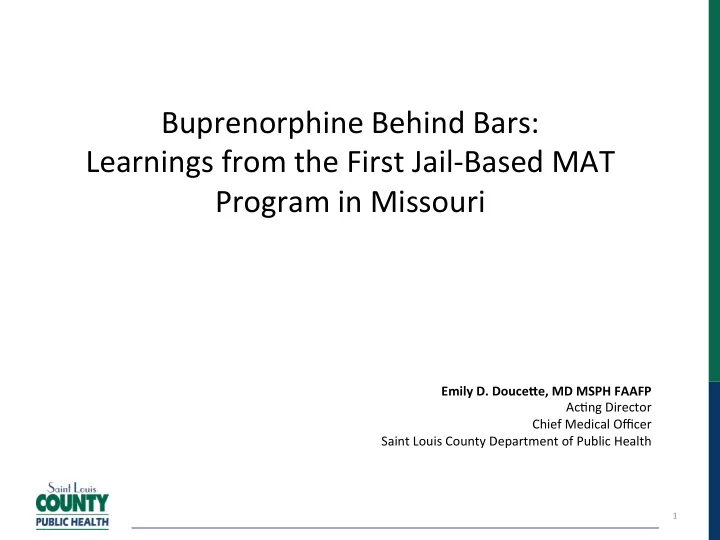

Buprenorphine Behind Bars: Learnings from the First Jail-Based MAT Program in Missouri Emily D. Douce-e, MD MSPH FAAFP Ac%ng Director Chief Medical Officer Saint Louis County Department of Public Health 1
Current Landscape: A High Need, Underserved Popula%on • Out of several thousand local and county jails, fewer than 200 provide MAT, and the protocol is primarily limited to injected naltrexone immediately before individuals are released.* • People recently released from incarcera%on have overdose death rates up to 130 %mes higher than the general popula%on in the first few weeks aUer release.** • Rhode Island saw a rela%ve risk reduc%on of 61% aUer implemen%ng MAT in their unified jail/prison system.*** • St. Louis County is the first Correc%onal facility in the state to offer buprenorphine products for maintenance purposes. * Jail-Based Medica%on-Assisted Treatment: Promising Prac%ces, Guidelines, and Resources for the Field (2018). ** Ingrid A. Binswanger et al., Release From Prison—A High Risk of Death for Former Inmates, 356(2) New Eng. J. Med. 157, 157, 160–61 (2007) *** Green, T. C. et al. (2018). Pos%ncarcera%on fatal overdoses aUer implemen%ng medica%ons for addic%on 2 treatment in a statewide correc%onal system. JAMA psychiatry, 75(4), 405-407.
Local Context • The Department of Public Health provides all medical care in the St. Louis County Jail. • In 2018, there were 23,895 bookings, 10,149 admissions, 11,270 total inmates housed, and an average daily popula%on of 1,203. • 14-19% of individuals admiged are likely to have opioid use disorder. Other substance use disorders are also prevalent. • Un%l 2019, all individuals admiged with posi%ve opioids on entrance drug screens (including illicit opioids and MAT medica%ons) underwent withdrawal.* • A small number of individuals received a Vivitrol injec%on just prior to release. *Pregnant women are an excep%on; they were transported to an OTP to receive methadone 3
Common Concerns Our job is to keep controlled Isn’t this just substances out of the facility. subs%tu%ng one Now you want us to bring them addic%on for another? in on purpose? How do we fit this into our busy daily opera%ons? People come in on so many How do we explain why some different substances. How do we people get this medica%on even decide when to do this? and others don’t? 4
Selng the Program Up to Succeed Ensuring that Jus%ce Services and Public Health were prepared to work together as a team was cri%cal. How did we do this? • Invi%ng security and medical experts who have implemented similar programs in criminal jus%ce selngs to share their experiences including unan%cipated challenges and crea%ve solu%ons • Emphasizing how the program aligns with both departments’ missions • Including staff from both departments in planning sessions and trainings, from leadership down to line staff • Maintaining open lines of communica%on between JS and DPH throughout program planning and implementa%on 5
Phased Approach • Individuals already stable on treatment: med. selec%on not a concern, no new induc%ons • Reduces re-entry obstacles because pa%ents already have a community-based provider Maintain • Provides for a small, controlled roll-out to adjust procedures before a wider roll-out Community Tx • Reduces re-entry obstacles because individuals have a pre-determined release date Ini%a%ng • Provides built-in psychosocial support to accompany medical treatment Choices Par%cipants • Has the poten%al to have the largest impact but also presents the greatest challenges in terms of screening, logis%cal limita%ons, cost, and ability of community-based providers Ini%a%ng to absorb individuals aUer release General Popula%on 6
Opera%onal Components • Staffing – Program manager – Nurse case manager – Discharge planner – Correc%ons officer %me • Medica%on Administra%on procedures – Timing and loca%on of med dosing – Mouth checks – Buprenorphine formula%on and dosing decision – Methadone considera%ons • Clinical procedures – Assessment and inclusion criteria – Addressing complex polysubstance withdrawal – Psychosocial services • Parallel Jus%ce Services and Public Health disciplinary systems 7
Addressing Unique Challenges of a Jail Selng Pa%ent Iden%fica%on/Selec%on • How are individuals selected in an environment where mental health comorbidi%es and polysubstance use are the rule rather than the excep%on? • The stress of incarcera%on can further complicate screening and diagnosis Discharge Planning • Release dates are unpredictable • Most are uninsured, Medicaid is terminated upon incarcera%on • Some will be released to another jail or prison, which do not provide MAT services Security and Opera%ons • How are controlled medica%ons brought into the facility? • How is diversion prevented? • How will supervised dosing fit into a rigid schedule? 8
Ques%ons? 9
Recommend
More recommend